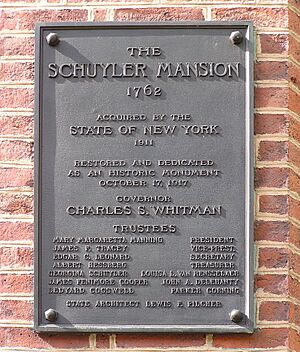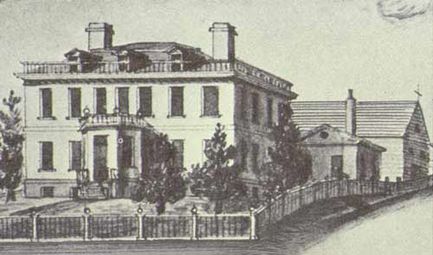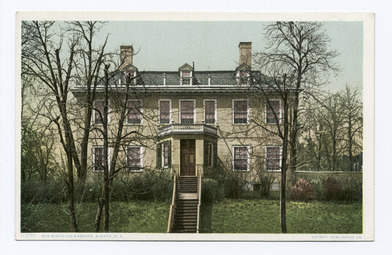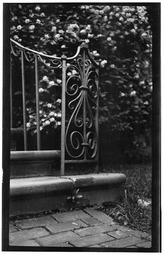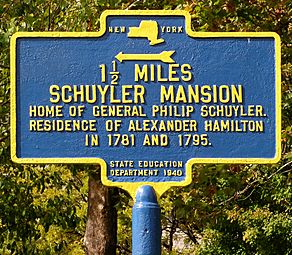Schuyler Mansion facts for kids
|
Philip Schuyler Mansion
|
|
|
U.S. Historic district
Contributing property |
|
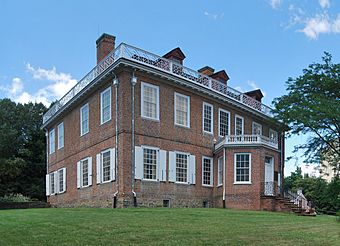
South profile and east elevation, 2011
|
|
| Location | 32 Catherine Street, Albany, New York, United States |
|---|---|
| Built | 1761–1765 |
| Architect | John Gaborial |
| Architectural style | Georgian |
| Part of | South End–Groesbeckville Historic District |
| NRHP reference No. | 67000008 |
Quick facts for kids Significant dates |
|
| Added to NRHP | December 24, 1967 |
| Designated NHL | December 24, 1967 |
The Schuyler Mansion is a famous old house in Albany, New York. It's made of brick and is now a museum. It's also recognized as a special National Historic Landmark. This grand house was built between 1761 and 1765 for Philip Schuyler. He later became a general in the Continental Army during the American Revolution. Philip Schuyler also served as an early U.S. Senator. He lived in the mansion from 1763 until he passed away in 1804. The mansion was officially named a National Historic Landmark on December 24, 1967. It is also part of the South End–Groesbeckville Historic District. This district was added to the National Register of Historic Places in 1984.
Contents
History of Schuyler Mansion
General Philip Schuyler, a hero of the Revolutionary War, started building his large Georgian-style home in 1761. It was located near Albany, New York. Before this time, it was not safe to build outside the city. This was because of the French and Indian War. So, the family's mansion was built from 1761 to 1765. This was near the end of that war.
The mansion was built on 80 acres of land. It was about half a mile from the city. When the Schuylers moved in, Philip and his wife, Catherine Van Rensselaer Schuyler, had three daughters. Their names were Angelica, Elizabeth, and Margarita. Margarita was also called Peggy.
Philip and Catherine had fifteen children in their lifetime. However, only eight of them lived past infancy. The three older daughters were born close together. They were known as the famous Schuyler sisters. After moving into the mansion, Catherine had three boys: John Bradstreet, Philip Jeremiah, and Rensselaer. Then came two more girls, Cornelia and Catherine.
Mansion's Role During the Revolution
During the Schuyler family's time, the mansion was a busy place. It was a center for military plans, business, and family life. For example, Philip and Catherine's daughter Elizabeth married Alexander Hamilton there. Hamilton was a very important figure in early American history.
Later in the American Revolution, Philip Schuyler worked as an intelligence officer. He ran a network of spies from his home. These activities led to an attempt to kidnap him. This happened on the night of August 7, 1781. However, the attempt failed.
The Schuyler family was also known for being very welcoming. Many important guests stayed at the mansion. These included George Washington, Martha Washington, Benjamin Franklin, and James Madison. Even the British general, John Burgoyne, stayed there in 1777. He was a "prisoner guest" after the Battle of Saratoga.
Changes After Philip Schuyler's Death
After Philip Schuyler passed away in 1804, his land was divided. It included over one hundred building lots. These were shared among his six living children. But none of his children wanted the house itself. They had already settled down with their own families elsewhere.
So, in 1815, the mansion was sold to a furrier named John Bryan. Bryan lived in the mansion for about 29 years. He made several changes to the house. He added a vestibule, which is like an entryway. This was built by local architect Philip Hooker and is still there today.
In 1844, Ezekiel C. McIntosh bought the mansion. He was the president of the Mohawk and Hudson Railroad Company. After McIntosh died in 1855, his wife, Caroline Carmichael, married former U.S. President Millard Fillmore. Their wedding took place in the same room where Alexander Hamilton and Elizabeth Schuyler were married. The Fillmores then moved to Buffalo, New York.
The mansion was then rented to John Tracey and his family. The Tracey family removed any smaller buildings that were still on the property from Philip Schuyler's time. In 1882, after Caroline Fillmore died, the Traceys moved out.
The next owner was Lansing Pendleton Jr., a watchman. He owned the house for a short time. In 1886, he sold it to the Roman Catholic Diocese of Albany for $7,000. The mansion was then used as an orphanage for young children. It was run by the Sisters of Charity and called St. Francis de Sales Infant Asylum.
Under the Diocese, the mansion's main living room became a chapel. Many of the fireplaces were also closed up. The orphanage soon needed more space. They even built a second building, which was later torn down. It became clear that the Diocese either had to tear down the mansion or sell it. The sisters in charge wanted to save the mansion. They refused to sell it to anyone except the state or a "patriotic society."
New York State Buys the Mansion
On March 22, 1911, the mansion was sold to the state of New York. The state planned to turn it into a historic site for everyone to visit. The museum's first board of directors included Philip Schuyler's great-granddaughter, Georgina Schuyler. It also included the son of John Tracey, who had lived in the house earlier.
The orphanage built its new site over the next few years. They moved out of the mansion on January 30, 1914. After more than three years of careful restoration, Schuyler Mansion opened to the public. This happened on October 17, 1917. It was the 140th anniversary of the Battle of Saratoga.
Mansion Structure and Design
Schuyler Mansion is a large, two-and-a-half-story Georgian house. It is about 67.5 feet wide and 47.5 feet deep. It was built between 1761 and 1765. The house sits on a sloped area in southern Albany. It faces east, looking toward the Hudson River.
The walls are made of brick. They are laid in a pattern called English bond. The building has a double-pitched hip roof. A wooden balustrade surrounds the roof. It has Chinese fret panels and posts topped with urns. This balustrade was added in the early 1800s, not when the house was first built. Two brick chimneys rise from inside the roof.
John Gaborial, a master carpenter from Boston, Massachusetts, oversaw the building of the mansion. When the house was built, two separate wings were added behind it. The building on the southwest side was used as an office. The one on the northwest side was the kitchen. These wings were removed in the 1800s. The space they once filled is now a garden.
The house follows a center-hall plan, common for Georgian homes. Both the first and second floors have two rooms on each side of wide hallways. Each room is about 18 by 19 feet. The entrance hall is 48 feet long, 20 feet wide, and 12 feet high. It is divided near the back by a doorway supported by columns.
The inside of the mansion is very decorative. The thick brick walls allow for special window shutters. These shutters fold into the window frames. The walls of the main hall were plastered. Then, they were covered with scenic wallpaper brought from France. The main staircase has spiral balusters. These are decorative posts with three different shapes on each step.
Photo gallery
See also
- History of Albany, New York
- List of National Historic Landmarks in New York
- List of New York State Historic Sites
- National Register of Historic Places listings in Albany, New York
- Ten Broeck Mansion
- General Schuyler House




